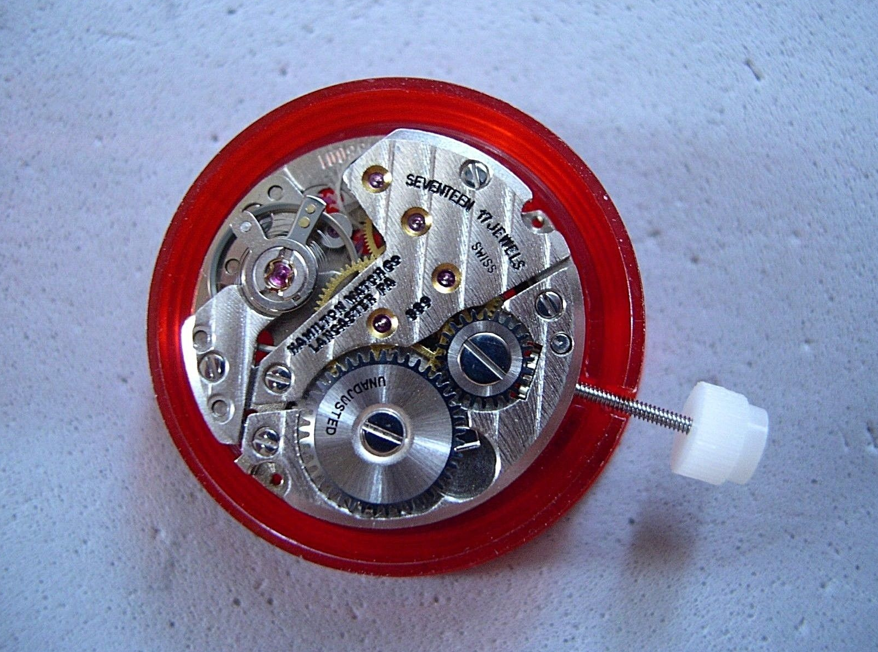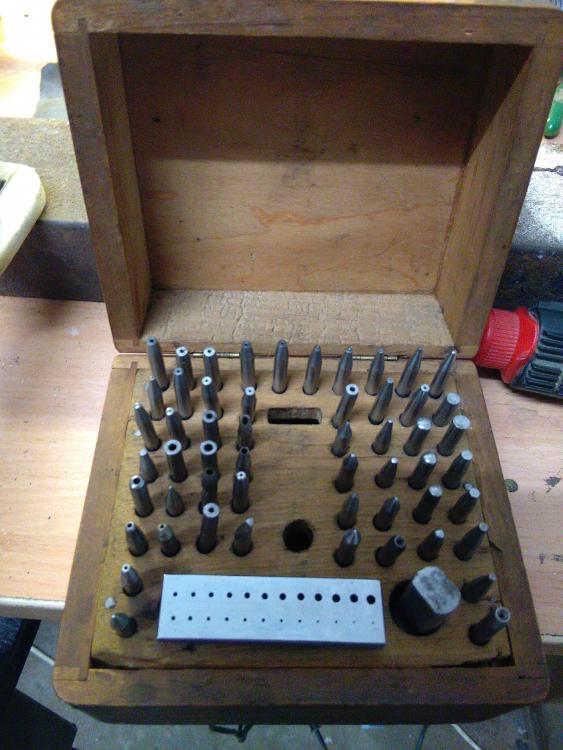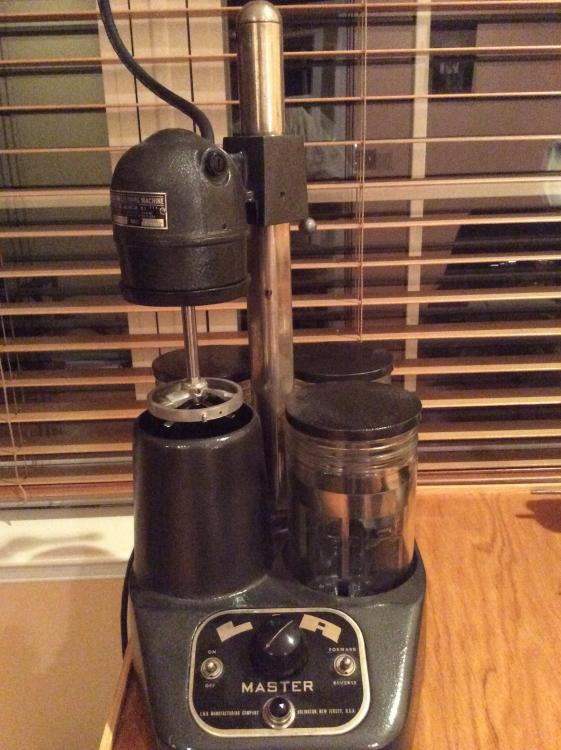Leaderboard
Popular Content
Showing content with the highest reputation on 09/25/16 in all areas
-
2 points
-
what you broke i think is called a split pin. The arrows under the links show the direction to remove the pins. When removing, the end with the split comes out first when pushing in the direction of the arrow.1 point
-
Is this happening with the movement in or out of the case. If the the movement is cased up I would say the stem is to short.1 point
-
1 point
-
The bridge with the oscillating weight retaining screw thread post, this can be replaced, a new one pressed fit, but in your instance, you would be better off replacing the bridge itself. I have only come across the problem you are having once, and I simply replaced the bridge. I did look closely at the bridge from the underside, and it looks like the thread post is renewable, but have never seen the post being sold on its own before.1 point
-
A converted Hamilton for me today.... This is the "Registered Edition" Piping Rock that had a Hamilton Quartz Movement in it until yesterday when I exchanged it for a Hamilton automatic movement . The new movement did not come with an hour wheel so after not being able to find the proper hour wheel for this movement , [yet] , I went rummaging through some old movement watch lots I have had for about 4 years . These junk movements were sitting in the back of a drawer , and there were bits and pieces from different watches with names I had never heard of . There were several hour wheels so I figured I had nothing to lose by trying to fit them to the Piping Rock movement . Would you believe one of them fit the cannon pinion and mated with the minute wheel . I was looking at it and I couldn't believe it . The hour wheel was .06 mm too tall , and the O.D. was a skosch larger than the hole in my hour hand . I carefully filed the hour wheel down .06 mm and finished out the rough edge with a sanding stick . Then I very carefully broached out the hole on my hour hand and fitted it . By another stroke of luck the winding stem with the crown from my quartz movement fit the automatic movement to wind it and set the hands , but the stem from the auto movement is a tiny bit too big to slide into the quartz movement ,....I'll use the quartz stem with the crown attached as the length is correct . The watch has been running for about 8 hours so far with no problem , but I'll wear it for the next couple of days and see if it makes it through the trials . I've attached some links at the end in case anyone is interested in a little history of the Piping Rock . http://www.hamiltonchronicles.com/2012/09/1928-piping-rock.html http://www.hamilton-museum.com/museum http://www.vintage-hamilton-wristwatches.com/2015/03/hamilton-piping-rock-registered-edition.html1 point
-
Don't know yet. Assembling the watch tomorrow. Hope all is right, including the height of the jewel. Sent from my iPhone using Tapatalk1 point
-
Thanks Bob. Assembling the watch tomorrow Sent from my iPhone using Tapatalk1 point
-
I recently conducted an experiment to compare the solubility of shellac in isopropyl alcohol and acetone. I put equal size flakes of shellac in small glass beakers containing equal volumes (about 20 ml) of solvent. The shellac did not at all dissolve in the isopropyl alcohol. It did slowly dissolve, albeit incompletely, in the acetone. The acetone was discolored by the shellac. I let the acetone evaporate over a few days. By then, the original flake, somewhat blander in color, was still present. However, the bottom of the glass beaker was coated with hard shellac. I needed to use acetone and vigorous scrubbing to clean the beaker. If I were a REAL scientist, I would carefully measure the weight of the shellac flake before and after its immersion in the acetone. Then, knowing the volume of the acetone containing the decrement of shellac mass, I could calculate the concentration of shellac in a saturated solution of acetone. From that I could calculate the volume of the saturated solution I would need to fill a hole of known volume with shellac, probably by multiple applications. Fortunately, a microdrop of acetone has a very high surface area to volume ratio, and will evaporate quite quickly. I suspect that heated acetone would contain more dissolved shellac, but heating acetone sounds like a hazardous activity. I hope that one of you guys will try this approach and report back to us. —Eric Ohio. USA Sent from my iPad using Tapatalk1 point
-
1 point
-
Have been reading with interest the threads about watch cleaning machines and I thought I'd post a pic of mine that I purchased on eBay a few years back, old L&R Master, it was in a pretty unloved state when I bought it, motor ran, heater did not and paint finish was all chipped, worn off and just looked not nice, I paid $130 for it as I knew it could be brought back to life with a little love and attention. I re wired the whole unit (original looked downright hazardous, threadbare fabric insulation) and rubbed down paintwork and sprayed unit and jar lids with grey hammerite paint, replaced the bulb inside the red display switch and the heater was operating, (the builb acts as the fuse for the heating element). Spent under $20 in Home Depot for everything that I needed. Hoping this might help someone who has been looking to get a machine, it really was a pleasing job fixing it up and it's a great little machine that I now love dearly.1 point
-
1 point
-
With a medium sized screwdriver you can take outa drop which is enough for 5 watches1 point
-
Conveniently I can't find the box my Elgin oil came in to show a picture of what they had. So they had if I remember two separate lids the normal lid and another one that had a glass rod with a small ball on the end. So when you inserted into the bottle which was bigger than the moubius bottle you would get a small amount oil out. Using glass like this is nice as it's easy to clean and shouldn't contaminate the oil. Despite the advertisements from moubius at one time promoting their oil lasted forever now the recommendation is tossing the bottles every couple of years I suspect more because contamination in the bottle than actual breaking down. Then I've seen companies like Rolex put their lubricants in a syringe to avoid this problem. I have asked other watchmakers they use the same method that I use. A very clean pair of tweezers usually like number five as they're small enough. Insert into the bottle when they're closed they will pick up a small droplet of oil. When you open them up slowly the droplet will fall off or run down the ends into the oil cups. They just make sure you clean your tweezers carefully afterwards.1 point












